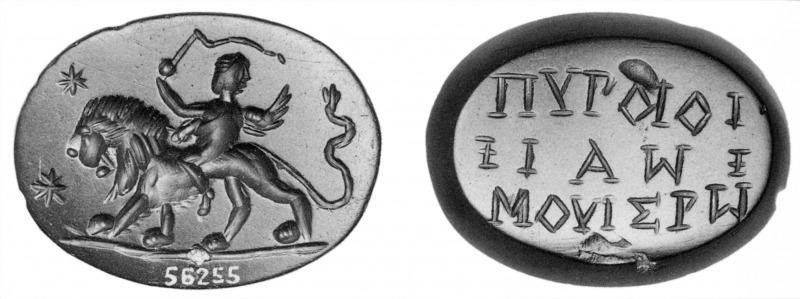Bonner, SMA, 200.
Σερπωτ. A very strange amulet described in the catalogue of the Museo Borgiano represents a monster with human trunk and arms, scorpion pincers in place of legs, and seven snakes in place of a human head.75 In the field are a lotus flower, a ram's head, and a lion's head (this must have been the engraver's intention, though Zoega says “head of an ox with a mane”). Over these objects are the words ερπωτ, μουι, σρω, meant for the Coptic serpōt (sarpot), moui, sro, “lotus,” “lion,” “ram.” This is the name of the god with whom the operator identifies himself in certain passages of the magical books, and is attested some centuries earlier, according to Griffith and Thompson, who think that lotus, lion, and ram all represent solar attributes.76 Matter published an equally strange figure from an oblong plaque of lapis lazuli in the Cabinet des Médailles. This is a monster with human trunk, arms, and thighs, but with the lower part of the legs and the feet like those of some animal. The knees are bent as if in dancing. From the shoulders rise seven snakes, so crowded and so stiffly rendered as to resemble a grating with upright bars. Over them projects a large, crudely stylized lotus, with a lion's head projecting from one side of its stem, a ram's head from the other.77 The words σερφουθ μουι σρω are in the upper field. In PGM VII, 498, the operator calls himself “the god whose seat is in Pelusium, σερφουθ μουι σρω” — in this case probably Harpocrates. Μουι σρω is one of a list of names with solar associations in PGM XXXVI, 351. The same two words are inscribed on the reverse of a strange design in which Eros figures, a Graeco-Roman gem in the British Museum.78
Τασβερβερετας usually encircles the figure of Bes, the guardian of infancy, which is the reverse of the amulets showing Isis holding the child Harpocrates, described above in connection with the αθθα βαθθα formula. It sometimes occurs without an accompanying design, as a charm powerful in itself.79
Ωρθμενχινιαμβων engraved on the reverse of several amulets of yellow jasper with the obverse design of a scorpion.80 They were probably intended to protect from the sting of the creature or to cure it. The word offers no hold for linguistic interpretation and, as in other cases discussed above, its application to this particular design is merely arbitrary (see pp. 77-78).
75 Museo Borgiano, p. 454, 19.
76 DMP 1, 12; PGM III, 659.
77 Matter, Pl. 1 F, 1; described by Chabouillet 2170, not quite accurately. A greatly enlarged which appeared in the short-lived periodical Documents, II, 5 (Paris, 1930), shows the seven snakes more plainly, but is otherwise no better than the drawing in Matter.
78 B. M. Cat. Gems, 1515, Pl. 20. Walters describes the design as “Eros carrying bow, walking behind a boar to r.; the boar has a goat's head in its mouth.” Lions are often shown on gems holding in their jaws the head of a goat or an ox. But this seems to be “lion-boar” rather than “lion-ram,” as the inscription on the back would lead one to expect; for poor as the work is, it is scarcely possible that a ram was intended.
Here we may mention another stone in the same museum (56255), a green jasper representing a winged child holding a whip and riding a lion; two stars in the field. The deity is Harpocrates assimilated to Eros. The back is inscribed πυροιοι Ιαω μουι σιω. The first word may be a corruption of πυροείς, the last an error for σρω, thus giving the combination μουι σρω, lion-ram.
Here we may mention another stone in the same museum (56255), a green jasper representing a winged child holding a whip and riding a lion; two stars in the field. The deity is Harpocrates assimilated to Eros. The back is inscribed πυροιοι Ιαω μουι σιω. The first word may be a corruption of πυροείς, the last an error for σρω, thus giving the combination μουι σρω, lion-ram.
79 Mouterde, “Le Glaive de Dardanos,” p. 82; Petrie, Amulets, Pl. 22, 135 t.
Last modified: 2012-11-01 20:58:12
Link: cbd.mfab.hu/pandecta/1645


